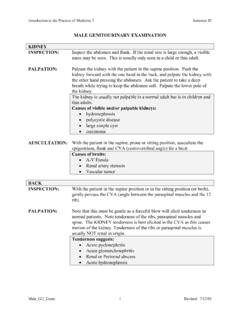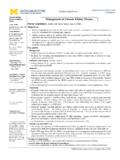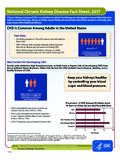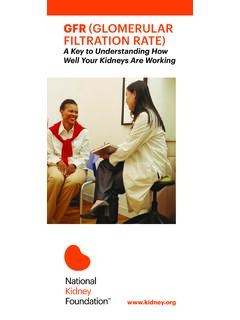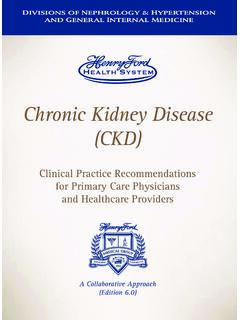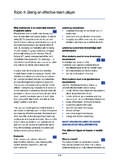Transcription of Table of Genetic Disorders
1 Table of Genetic Disorders disease Gene/Defect Inheritance Clinical Features Achondroplasia Fibroblast growth factor receptor 3 (FGR3) constitutively active (gain of function) Autosomal dominant (normal parents can have an affected child due to new mutation, and risk of recurrence in subsequent children is low) Short limbs relative to trunk, prominent forehead, low nasal root, redundant skin folds on arms and legs Cystic Fibrosis Cystic fibrosis transmembrane regulator (CFTR) impaired chloride ion channel function Autosomal Recessive (most common Genetic disorder among Caucasians in North America) Pancreatic insufficiency due to fibrotic lesions, obstruction of lungs due to thick mucus, lung infections (Staph, aureus, Pseud.)
2 Aeruginosa) Duchenne Muscular Dystrophy Dystrophin (DMD) - deletions X-linked recessive Gradual degeneration of skeletal muscle, impaired heart and respiratory musculature Hypercholesterolemia LDL receptor (commonly) Autosomal dominant (haploinsufficiency) Impaired uptake of LDL, elevated levels of LDL cholesterol, cardiovascular disease and stroke. Symptoms more severe in homozygous individuals Fragile X Syndrome (FMR1) CGG trinucleotide repeat expansion in 5 untranslated region of the gene (expansion occurs exclusively in the mother) X-linked dominant (females less severely affected) Inheritance characterized by anticipation Disorder shows anticipation (female transmitters in succeeding generations produce increasing numbers of affected males) Boys with syndrome have long faces, prominent jaws, large ears, and are likely to be mentally retarded.
3 Gaucher s disease -Glucosidase Autosomal recessive Lysosomal storage disease characterized by splenomegaly,hepatomegaly, and bone marrow infiltration. Neurological symptoms are not common Glucose 6-phosphate dehydrogenase deficiency Glucose 6-phosphate dehydrogenase X-linked recessive (prominent among individuals of Mediterranean and African descent) Anemia (due to increased hemolysis) induced by oxidizing drugs, sulfonamide antibiotics, sulfones ( dapsone), and certain foods ( fava beans) Hemochromatosis Unknown gene on the short arm of chromosome 6 Autosomal recessive (Incidence ~ in Caucasoid population. Women less affected due to increased iron loss through menstruation) Enhanced absorption of dietary iron with accumulation of abnormal, pigmented, iron-protein aggregates (hemosiderin) in visceral organs.
4 Cirrhosis, cardiomyopathy, diabetes, skin pigmentation, and arthritis. Holoproencephaly Sonic Hedgehog (SHH) Autosomal dominant (haploinsufficiency?)Malformation of the brain (no or reduced evidence of an interhemispheric fissure), dysmorphic facial features, mental retardation Huntington disease (Also Huntington Chorea) Huntingtin (HD) CAG repeat expansion within exon 1 (expansion occurs in father) Autosomal dominant (gain-of-function mutation) Shows anticipaton Disorder is characterized by progressive motor, cognitive and psychiatric abnormalities. Chorea nonrepetitive involuntary jerks is observed in 90% of patients Klinefelter Syndrome 47,XXY males 50% of cases due to errors in paternal meiosis I Sterile males with long limbs, small genitalia, breast development, and feminine body contours, and learning disabilities Marfan Syndrome Fibrillin-1 gene (FBN1) encodes a microfibril-forming connective tissue protein Autosomal dominant (dominant negative effect) Abnormalities of the skeleton (disproportionate tall stature, scoliosis), heart (mitral valve prolapse, aortic dilatation, dissection of the ascending aorta), pulmonary system, skin (excessive elasticity), and joints (hypermobility).
5 A frequent cause of death is congestive heart failure. Myoclonic Epilepsy with Ragged Red Fibers (MERRF) Mitochondrial DNA mutation in the tRNAlys gene Maternal transmission, heteroplasty Age of onset varies depending on fraction of mutant mitochondrial DNA inherited. Symptoms include myopathy ( disease takes its name from abnormal histological appearance of skeletal muscle biopsies), dementia, myoclonic seizures, ataxia, and deafness Myotonic Dystrophy A protein kinase gene (DMPK) CTG repeat expansion in 3 untranslated region of the gene Autosomal dominant Shows anticipation Disorder shows anticipation. Muscle weakness, cardiac arrhythmias, cataracts and testicular atrophy in males.
6 Children born with congenital form have a characteristic open triangle-shaped mouth Neurofibromatosis I Microdeletion at involving the NF1 gene Autosomal dominant The disorder is characterized by numerous benign tumors (neurofibromas) of the peripheral nervous system, but a minority of patients also show increased incidence of malignancy (neurofibrosarcoma, astrocytoma, Schwann cell cancers and childhood CML chronic myelogenous leukemia) Osteogenesis Imperfecta Either of the genes encoding the 1 or 2 chains of type I collagen Usually autosomal dominant (null mutations result in haploinsufficiency, missense mutations often produce a dominant negative effect Null mutations produce a milder form of the disease .)
7 Missense mutations that act in a dominant negative manner are often perinatal lethal. The Disorders are associated with deformed, undermineralized bones that are subject to frequent fracture. Phenylketonuria Usually due to a mutation in Phenylananine hydroxylase (PAH) Autosomal recessive Mental retardation, if untreated, possibly due to inhibition of myelination and disruption of neurotransmitter synthesis. Detectable by newborn screening and treatable Polycystic kidney disease Mutations in either polycystin-1 (PKD1) or polycystin-2 (PKD2) gene Autosomal dominant ( disease appears to follow a two-hit model , requiring the loss of both alleles of PDK1 or PDK2 for the disease to be evident.)
8 Heterozygous individuals are predisposed to polycystic kidney disease because they are likely to loose the second good copy of the gene during their lifetime. Multiple renal cysts, blood in urine, end-stage renal disease and kidney failure. Prader Willi/Angelman (PWS/AS) Deletion of the PWS region and AS gene located at 15q11-q13. Can also be caused by uniparental disomy involving chromosome 15 Complex Parent of origin effects due to genomic imprinting. Inheriting the deletion through the mother gives rise to Angelman syndrome, which is characterized by short stature, severe mental retardation, spasticity, seizures, and a characteristic stance. Inheriting the deletion from the father produces the more common Pader-Willi syndrome, which is characterized by obesity, excessive and indiscriminate gorging, small hands, feet, hypogonadism and mental retardation.
9 In rare cases, uniparental disomy involving chromosome 15 produces PWS when both copies are inherited from the mother and AS when both copies are inherited from the father. Sex Reversal Variety of causes Various See Thompson & Thompson, Medical Genetics, 6th ed. Tay-Sachs disease -Hexosaminidase (A isoenzyme (HEXA) Autosomal recessive (common among Jew of Eastern European ancestry and French Canadians). Hypotonia, spasticity, seizures, blindness, death by age 2. An early indication is a cherry red spot on the retina. (Incidence greatly reduced by screening ) Thalasemias Autosomal Recessive Severe anemia Turner Syndrome 45,X females Usually due to a paternal error in sex chromosome transmission Although usually lethal in utero, the defect poses little risk to survival in infants that do come to term.)
10 Short stature, webbed necks, broad chest with widely spaced nipples, and sterility. Infants show evidence of lymphedema in fetal life. Intelligence is normal. Xeroderma pigmentosum Anyone of nine genes involved in nucleotide excision repair (locus heterogeneity) Autosomal recessive characterized by variable expressivity, and Genetic heterogeneity Acute photosensitivity, premature skin aging, premalignant actinic keratoses, and benign and malignant neoplasms of the skin, including basal cell carcinoma, squamous cell carcinoma, or both. 5% of patients develop melanomas. Patients also exhibit ocular problems due to UV damage and have a 10- to 20-fold increased incidence of internal neoplasms due to an inability to repair DNA damage by endogenously generated and environmental genotoxic agents.
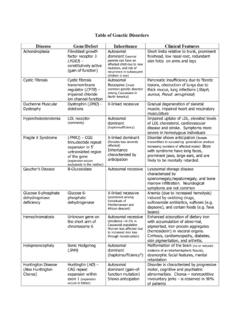
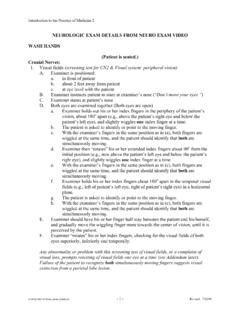
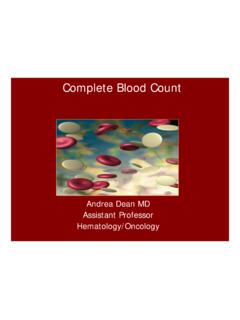

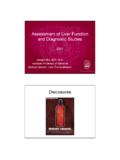
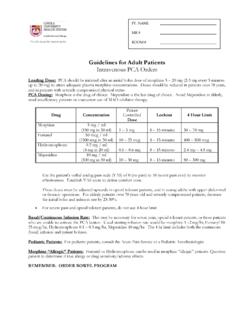


![WOUND HEALING lecture.ppt [Read-Only]](/cache/preview/2/b/6/c/1/4/7/f/thumb-2b6c147f08025508ccf4ec201274f3ba.jpg)
